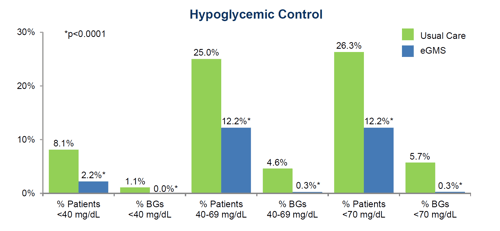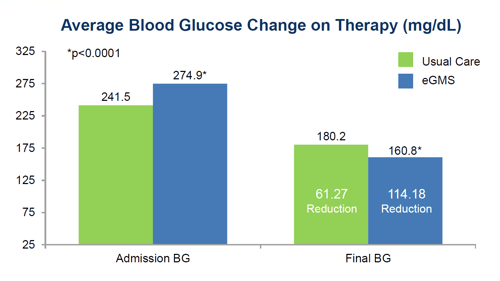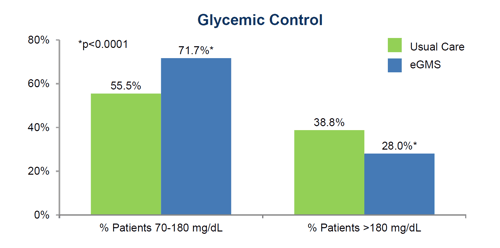Presentation
International Hospital Diabetes Meeting
Date
May 2017
Authors
Marina Rabinovich, Barbara McLean, Guillermo Umpierrez
OBJECTIVE
The benefits of optimal glycemic control in hospitalized patients have been widely studied and strategies should focus on controlling hyperglycemia and avoiding hypoglycemia. The primary objective of this study was to compare hypoglycemia among critically ill patients at a large academic medical center receiving insulin therapy by usual care versus eGlycemic Management System (eGMS). Secondary objectives were additional glycemic measures.
METHODS
Retrospective, single academic medical center comparison of patients receiving insulin therapy by usual care (UC) before and after implementation of eGMS. UC data collected from 8/17/16 to 1/29/17 and eGMS post go-live from 10/24/16 to 1/29/17.
| PATIENT DEMOGRAPHICS | Usual Care | eGMS |
|---|---|---|
| #Patients | 2,079 | 90 |
| Median Age (yrs) | 53 | 60 |
| Gender – Male | 49% | 36% |
| Gender – Female | 51% | 64% |
| Height (cm) | 163.51 | 171.64 |
| Weight (kg) | 81.76 | 86.75 |
| BMI | 29.02 | 29.56 |
| A1c | 8.97 | 9.35 |
| GFR | 42.88 | 48.0 |
RESULTS
For patients receiving UC (n=2,079), 32,850 blood glucose (BG) values were evaluated.
- The average initial BG was 241.48 mg/dL (SD=205.35), and the average final BG was 180.21 mg/dL (SD=98.16).
- 26.3% of patients (n=547) experienced hypoglycemia <70 mg/dL, and 8.13% (n=169) experienced severe hypoglycemia <40 mg/dL.
- 5.73% of BGs (n=1,881) were <70 mg/dL, and 1.11% (n=363) were <40 mg/dL.
For patients receiving care using eGMS (n=90), 7,615 BG values were evaluated.
- The average initial BG was 274.94 mg/dL (SD=99.29, p <0.0001), and the average final BG was 160.76 mg/dL (SD=48.74, p <0.0001).
- 12.2% of patients (n=11, p <0.0001) experienced hypoglycemia <70 mg/dL, and 2.22% (n=2, p <0.0001) experienced severe hypoglycemia <40 mg/dL.
- 0.28% of BGs (n= 21, p <0.0001) were <70 mg/dL, and 0.03% (n=2) were <40 mg/dL.
CONCLUSION
Compared to usual care, eGMS can significantly reduce adverse effects associated with insulin therapy in hospitalized patients while effectively optimizing glucose control in a large academic medical center environment.


